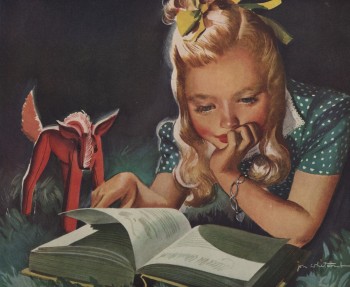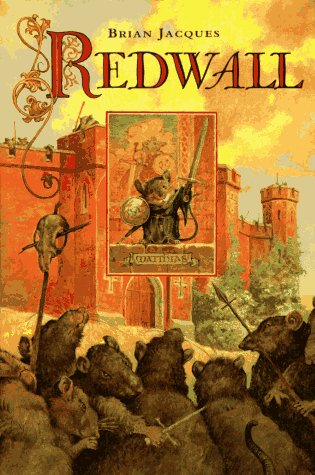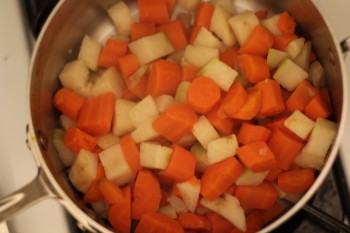
Reading, glorious reading.
Illustration by Jon Whitcomb
My friend and fellow writer Emmie Mears recently started a Facebook thread about beloved childhood books that quickly spiralled out of control. As soon as I thought I’d remembered all of my favorite books from my youth I thought of another cherished novel or series that had made an impression on me. The Chronicles of Narnia; Into the Land of the Unicorns; the Dark is Rising Series; Redwall; Harry Potter. Each remembrance filled me with a warm nostalgia for days spent curled up in the sunshine, lost in the thrilling pages of some new saga. But with each new remembrance came a recognition of a thread winding through all these childhood favorites: food.
Yes, food. Midnight feasts in cloistered dormitories. Exultant banquets celebrating the return of the unvanquished hero. Small sweets shared as a token of blossoming friendship. Children’s books celebrate food almost incessantly. Think of your favorite childhood novel and I can almost guarantee that at one point or another the characters will share in some ceremonial exchange of food.

I like the earwax flavor best.
Image courtesty of Warner Brothers
The Harry Potter series is a great example of this. The longest, strongest friendship in the novels, between Harry and Ron, is initiated over a shared delight in food. The image of Harry and Ron sharing Bertie Bott’s Every Flavor Beans and Chocolate Frogs across the aisle on the Hogwarts Express is unforgettable. They bond over food, and their friendship is likewise strengthened and elongated over a series of Hogwarts-based holiday feasts, midnight dormitory snacks, and simple but delicious home-cooked meals at the Weasley’s crowded yet loving Burrow house. Food acts as both a catalyst and a salve in the Harry Potter books; it serves to forge bonds and relationships while simultaneously soothing hurts and calming nerves.

Redwall, by Brian Jacques
Brian Jacques’ Redwall series takes this trope to even greater heights. The Redwall books follow the dynastic politics of a group of woodland animals living in a medieval-style abbey. I read the series when I was 9 or 10 and I remember being incredibly impressed by the scope of the vast, elaborate feasts enjoyed by the animals multiple times per novel. Unimaginable quantities of hearty, British-inspired fare is consumed by the characters, and each dish is described in lengthy detail by the author. The feasts occasionally verge on food fetishism, so immense is the care put into each description.
Tender freshwater shrimp garnished with cream and rose leaves, devilled barley pearls in acorn puree, apple and carrot chews, marinated cabbage stalks steeped in creamed white turnip with nutmeg…. crusty country pasties, and these were being served with melted yellow cheese and rough hazelnut bread.
And the feasts in Jacques’ books also serve to bring the characters together; to remember old friendships, celebrate new affections, and begin to heal opened wounds of heart or body. And after hacking at each other’s limbs for the past three hundred pages, the characters certainly appreciate the elaborate feasts, stuffing themselves silly while singing baudy drinking songs and clapping each other heartily on the back.

Mole’s Favourite Deeper’n’Ever
Turnip’n’Tater’n’Beetroot Pie.
Image courtesy of thelocalspoon.com
This type of conspicuous and symbolic food consumption seems to peter off in more mature young adult and adult fiction, but the role of food in both real life and fiction never truly disappears. Important annual holidays are marked by feasts shared with good friends and families, where we appreciate food not only for its nutritional value, but for its ability to bring us together and allow us to celebrate both the joys and sadnesses in real life. This truth is represented universally in fiction, but nowhere more unabashedly and joyously than children’s fiction. In that magical land, a secret midnight feast in a dormitory always marks the start of a lifelong friendship, and every happy occasion is celebrated with a vast feast described in perfect detail.
Do you have a favorite childhood book or series? Do you ever miss reading about grand feasts and banquets? Share your thoughts in the comment section below!
Just thought I’d point out- that girl is definitely reading a textbook. It’s got diagrams and curves all over.
What? No way. No one in the history of ever has looked that happy while reading a textbook.